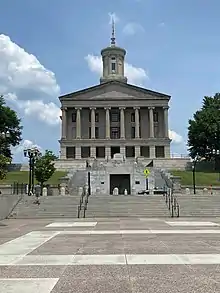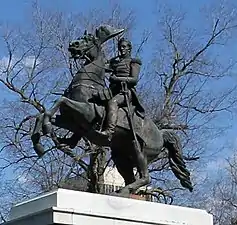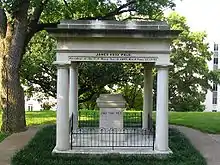Tennessee State Capitol
The Tennessee State Capitol, located in Nashville, Tennessee, is the seat of government for the U.S. state of Tennessee. It serves as the home of both houses of the Tennessee General Assembly–the Tennessee House of Representatives and the Tennessee Senate–and also contains the governor's office. Designed by architect William Strickland (1788–1854) of Philadelphia and Nashville, it was built between 1845 and 1859 and is one of Nashville's most prominent examples of Greek Revival architecture. The building, one of 12 state capitols that does not have a dome, was added to the National Register of Historic Places in 1970 and named a National Historic Landmark in 1971. The tomb of James K. Polk, the 11th president of the United States, is on the capitol grounds.
Tennessee State Capitol | |
 Tennessee State Capitol in 2022 | |
  | |
| Location | Capitol Hill Nashville, Tennessee |
|---|---|
| Coordinates | 36°9′57″N 86°47′3″W |
| Area | 4.9 acres (2.0 ha) |
| Built | 1845-1859 |
| Architect | William Strickland (1788-1854) |
| Architectural style | Greek Revival style |
| NRHP reference No. | 70000894 |
| Significant dates | |
| Added to NRHP | July 8, 1970[1] |
| Designated NHL | November 11, 1971[2] |
Description
The Tennessee State Capitol sits atop Capitol Hill, the highest point in Downtown Nashville. It is surrounded by a number of state government buildings, including the Tennessee Supreme Court building for the Middle Tennessee Grand Division. Directly south of the capitol is Legislative Plaza, a public plaza located between a number of state office buildings. North of the capitol is Bicentennial Capitol Mall State Park, a large public park that traces the state's history and geographic features.
The Tennessee State Capitol is modeled after an Ionic temple, incorporating Greek Revival architecture, and is composed of limestone quarried from nearby. It measures 112 by 239 ft (34 by 73 m), and is approximately 206.6 ft (63.0 m) tall. The north and south porticoes each contain eight Ionic columns, and the east and west porticoes, which do not span the entire length of the structure, contain six. All of the columns are capped by entablatures. On top of the roof is a 42 ft (13 m) tall round tower, modeled after the Choragic Monument of Lysicrates, that sits on a square pedestal-like structure. The tower contains eight Cornithian columns. The tower is topped by a 37 ft (11 m) tall cupola and finial, which in turn is topped by a flag pole.[1]
The building contains three stories. The first floor contains the office of the Governor and other state officials, including cabinet members. The House and Senate chambers are found on the second floor, as well as a room which housed the Tennessee State Library and Archives until 1953.[1]
History
Site history
When Tennessee was admitted to the Union on June 1, 1796, as the 16th state, Knoxville was its first capital. Over the next thirty years, the seat of government alternated between Kingston, Nashville, Knoxville, and Murfreesboro, before being moved to Nashville in 1826. The 1835 state constitution mandated that the General Assembly choose a permanent capital. In 1843, Nashville was chosen as the capital.[3]
The prominent Nashville hilltop site of what is now the Tennessee State Capitol was formerly occupied by the Holy Rosary Cathedral (no longer extant), the first Roman Catholic cathedral church in Nashville (with the Diocese of Nashville at that time once comprising the entire territory of the State of Tennessee).[4][5][6] The property was purchased by the city of Nashville for $30,000, and conveyed to the state government for $1.[7]
Design and construction
.jpg.webp)
The State Capitol was designed by renowned Philadelphia architect William Strickland, who modeled it after a Greek Ionic temple. The prominent lantern structure located above the roof line of the Tennessee state capitol is a design based upon the Choragic Monument of Lysicrates in Athens that honors the Greek god Dionysus doing battle with Tyrrhenian pirates.[8] The cornerstone of the Tennessee state capitol was itself laid on July 4, 1845 and the building was completed fourteen years later in 1859.[9] Its final cost was approximately $900,000 (equivalent to $29,313,000 in 2022).[10]
.jpg.webp)
The American Society of Civil Engineers has designated the building as a National Historic Civil Engineering Landmark in recognition of its innovative construction, which made unusually extensive use of stone and was an early example of the use of structural iron. Both the interior and exterior are built with limestone from a quarry about 1-mile (1.6 km) from the site. Some interior columns were built from single pieces of stone, requiring massive wooden derricks to hoist them into place. Wrought iron, instead of wood, was used for the roof trusses to reduce the building's vulnerability to fire.[11]

Commercial, convict, and slave labor were used in the project. Fifteen enslaved Black men worked on carving the Capitol's limestone cellar from 1845 to 1847; Nashville stonemason A.G. Payne was paid $18 a month for their labor. It is believed to be "the most significant project where the [Tennessee] state government rented slave labor".[12]
Strickland died five years before the building's completion and was entombed in its northeast wall. His son, F. W. Strickland, supervised completion of the structure. William Strickland also designed the St. Mary's Cathedral (located along the base of the capitol hill), as well as Downtown Presbyterian church located just a few blocks away from the state capitol.[5]
Samuel Dold Morgan (1798–1880), chairman of the State Building Commission overseeing the construction of the Tennessee State Capitol, is entombed in the southeast corner near the south entrance.
Monuments
Monuments on the Capitol grounds include statues of two of the three Tennessee residents who served as President of the United States: Andrew Jackson is represented by Andrew Jackson by Clark Mills, and Andrew Johnson by a statue by sculptor Jim Gray. The second President from Tennessee, James K. Polk, is buried in a tomb on the grounds, together with his wife, Sarah Childress Polk.[13][14] Other monuments on the grounds include the Sgt. Alvin C. York Memorial by Felix de Weldon, the Tennessee Holocaust Commission Memorial, the Sam Davis Memorial at the southwest corner of the Capitol grounds, and the Memorial to Africans during the Middle Passage at the southwest corner of Capitol grounds. The Charles Warterfield Reliquary is a group of broken limestone columns and fragments removed and saved from the State Capitol during the mid-1950s restoration, located near the northern belvedere on Capitol Drive. In 1957, the Capitol building was struck by an F2 tornado.
On May 30, 2020, the Sen. Edward Ward Carmack Memorial located above the Motlow Tunnel near the south entrance was toppled by protestors during a demonstration in response to the police murder of George Floyd.[15] During the Nashville Autonomous Zone the area near where the statue stood has been unofficially claimed by protesters as "Ida B. Wells Plaza", after the anti-lynching advocate whose death had been advocated by Carmack.
The building housed a bust of Nathan Bedford Forrest between 1978 and 2021. This bust resulted from legislation introduced by Democratic state senator and Sons of Confederate Veterans member Douglas Henry in 1973, and its presence was controversial since its dedication.[16] Legislation was proposed in 2017 towards moving it to the Tennessee State Museum.[17] The Tennessee Historical Commission voted 25-1 on March 9, 2021, to move the bust to a museum as soon as possible.[18] The bust was removed on July 23, 2021, and was relocated to the Tennessee State Museum three days later.[19]
 Night time view of the Capitol
Night time view of the Capitol Andrew Jackson Statue located on the grounds of the Tennessee State Capitol
Andrew Jackson Statue located on the grounds of the Tennessee State Capitol Tomb of James K. Polk located on the grounds of the Tennessee State Capitol
Tomb of James K. Polk located on the grounds of the Tennessee State Capitol Senate chamber in 2022
Senate chamber in 2022 House chamber in 2022
House chamber in 2022 Old Supreme Court Chamber in 2022
Old Supreme Court Chamber in 2022 Library in 2022
Library in 2022 Second floor corridor in 2022
Second floor corridor in 2022
See also
References
- "National Register Information System". National Register of Historic Places. National Park Service. March 13, 2009.
- "Tennessee State Capitol". National Historic Landmark summary listing. National Park Service. Archived from the original on May 9, 2009. Retrieved September 3, 2009.
- Langsdon, Phillip R. (2000). Tennessee: A Political History. Franklin, Tennessee: Hillboro Press. p. 104. ISBN 9781577361251 – via Internet Archive.
- "FIRST - Catholic Church in Tennessee - Nashville, Tennessee - First of its Kind on Waymarking.com". Waymarking.com. Retrieved August 18, 2017.
- "Capitols and churches: Built and buried in Nashville • Tennessee Star Journal". Tnsjournal.com. December 22, 2015. Retrieved August 18, 2017.
- "CATHOLIC ENCYCLOPEDIA: Nashville". Newadvent.org. Retrieved August 18, 2017.
- McGee, Nikki (May 8, 2021). "Little-known facts about the Tennessee State Capitol". WKRN-TV. Nashville. Retrieved January 1, 2022.
- "Choragic Monument of Lysicrates". famouswonders.com. June 12, 2013. Retrieved August 18, 2017.
- The Tennessee State Capitol: A Self-Guided Walking Tour. Tennessee State Museum. 2009.
- Kerr, Gail (June 27, 1994). "Laying out a new era; Mall heralds revitalized city". The Tennessean. Nashville. pp. 1A, 2A. Retrieved January 1, 2022 – via Newspapers.com.
- "Tennessee State Capitol". American Society of Civil Engineers. Retrieved January 29, 2022.
- Iv, Thomas Joseph Broderick (June 3, 2008). "They Moved the Earth: The Slaves Who Built the Tennessee State Capitol". Vanderbilt Undergraduate Research Journal. 4. ISSN 1555-788X. Retrieved February 23, 2015.
- Burke, Sheila (March 24, 2017). "Plan to dig up President Polk's body – again – stirs trouble". Yahoo. Associated Press. Retrieved March 26, 2017.
- Resolution to move former President James K. Polk's body approved - CBS News
- "Toppled statue just some of damage at Tennessee capitol after Floyd protests". June 2020.
- Ebert, Joel (August 18, 2017). "Nathan Bedford Forrest bust at the Tennessee Capitol: What you need to know". The Tennessean. Retrieved September 5, 2017.
- Natalie Allison; Dave Boucher (December 15, 2017). "Bill filed to relocate Nathan Bedford Forrest bust from state capitol to Tennessee State Museum". The Tennessean.
- Falconer, Rebecca (March 9, 2021). "Tennessee to remove monument of KKK leader from state Capitol". news.yahoo.com. Axios. Archived from the original on March 10, 2021. Retrieved March 10, 2021.
- Allison, Natalie (July 23, 2021). "The bust of Nathan Bedford Forrest is out of the Tennessee Capitol. Here's how it happened". Tennessean. Retrieved July 23, 2021.
External links
- Tennessee State Museum Archived January 15, 2010, at the Wayback Machine - State Capitol information
- Tennessee Legislature Website
- Documentary: Tennessee State Capitol - Grounded in Tradition

